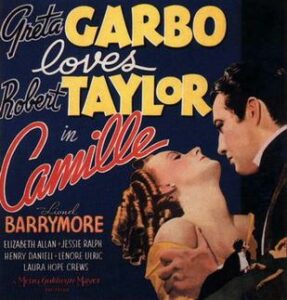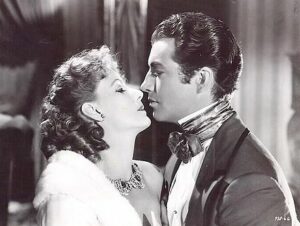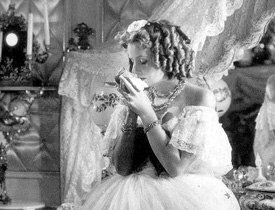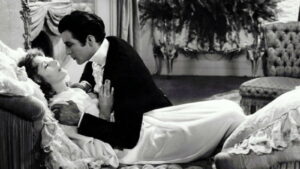“Camille” – No One Suffers as Beautifully as Garbo

Title: “Camille”
Release Date: 1936
Director: George Cukor
Cast: Greta Garbo, Robert Taylor, Henry Daniell, Lionel Barrymore, Elizabeth Allan, Lenore Ulric, Laura Hope Crews
“Camille” by George Cukor left audiences with an unsurpassed screen incarnation of the main character. Marguerite Gautier, from the famous novel by Alexandre Dumas’ son, forever gained the face of Greta Garbo, after whom no other actress has succeeded in so evocatively portraying the drama of the young, beautiful courtesan. Shot with great panache, Cukor’s film is a unique work, refined to the smallest detail. The picture impresses even decades after its premiere.
“Camille” – a romance between Alexandre Dumas and Marie Duplessiss
Alexander Dumas’ son’s novel “Camille” was published in 1848. The plot of the work was based on the authentic story of the writer’s relationship with the famous Parisian courtesan, Marie Duplessis. The beautiful connoisseur of art and hostess of an artistic salon became a legend of her era. The most influential men vied for her charms. Marie Duplessis earned the nickname “lady of the camellias” thanks to her favorite flowers, which always adorned her outfits. The famous courtesan contracted pulmonary tuberculosis and died at the age of only 23.
Dumas changed the personalities of the novel’s main character, calling her Marguerite Gautier. He also turned his novel into a play, and on theatrical stages such celebrities as Sara Bernhardt, Helena Modrzejewska and Eleonora Duse played the main role. The melodramatic story was also very quickly picked up by the cinema. In subsequent adaptations, Margaret was played by the aforementioned Bernhardt (at the age of 67), Alla Nazimova and Norma Talmadge. After the 1936 screen adaptation, the heroine was played by Micheline Presle, Isabelle Huppert and, in Poland, Anna Radwan. Nevertheless, neither before Cukor’s film nor later did any of the actresses create creations on the scale of Greta Garbo.

“Camille” – a sad story of Margaret Gautier and Armand
“Camille” is a story of beautiful and pure love. Young Armand Duval falls in love with a beautiful Parisian courtesan who is a retainer of the Baron de Varville. The lady initially resists the young man’s affections, but eventually reciprocates his affection and decides to abandon the wealthy aristocrat and her current lifestyle. The couple in love goes to the countryside, where they enjoy a simple life and love. One day, however, in Duval’s absence, his father shows up and convinces Marguerite that she should send her lover away. After all, a relationship with her will irrevocably destroy his reputation and sink his family.
The desperate girl gives in to her father Armand’s plea and returns to the baron. Meanwhile, the bachelor, raging with jealousy, wins a large sum of money and humiliates Marguerite by publicly paying “for her services” and then leaves Paris. After some time, Armand returns with the idea of reconciling with his beloved. However, it is too late, as the girl dies of tuberculosis.
“Camille” – a spectacular screen adaptation of Cukor.
The film “Camille”, directed by George Cukor, is the most outstanding of the existing screen adaptations. The work was realized with great panache, no expense was spared on decorations and costumes. Especially the latter are tremendously impressive. Adrian, Greta Garbo’s regular designer, rose to the challenge by creating costumes that are not only phenomenal, but also symbolic. Initially, Marguerite appears in white creations, only to later don black mourning gowns as the story unfolds and the mood grows more serious. Similarly, Garbo’s hairstyle evolves: from perfectly styled elegant curls, to loose weaves, which reflects the inner metamorphosis of the heroine.

The excellent script was wonderfully adapted, and William Daniels’ cinematography made the story a real visual feast. The scenes in the theater, in Marguerite’s house or the open-air locations in the French countryside were wonderful. The mood of 19th century Paris – a city of great opportunities, art, great business and debauchery – was successfully captured. It is a world in which true love seems almost impossible. For everything is lost in the depths of the pursuit of power and money. Yet it is in the very center of the broken reality and false relationships that great, pure love happens.
The entire world depicted was constructed on the basis of precisely the game of appearances, in which only occasionally one can see manifestations of the characters’ true feelings. Infatuated with Marguerite, the Baron has a truly demonic countenance, and friends partying at Gautier’s expense steal from her at every opportunity and even at her deathbed appear only to recover the money lent to the sick woman. Also the character of Marguerite herself is not free from a kind of cynicism. This balancing act between truth and appearance is best conveyed by the famous “duel at the piano”, when the Baron unexpectedly interrupts his lover’s tryst with Armand.
De Varville (a great role by Henry Daniell) then sits down at the piano, and his playing reflects his growing agitation caused by suspicion of betrayal: he moves from Chopin to louder and louder musical tones. Meanwhile, Marguerite, who is standing at the piano, pretends not to know that it is Armand banging on the door and tries to drown out the sound of the bell with forced laughter, while fiddling with her rosary. The scene is downright perverse – it captures the hypocrisy of the Parisian world, the deliberate tarnishing of sanctity, but also the pleasure the characters take in such order.

“Camille” – Greta Garbo and Robert Taylor
The phenomenal Greta Garbo in “Camille” was partnered by Robert Taylor. The actor in the role of Armand, of course, does not match the famous star, but does not come off worst. As Cukor recalled years later, his youth justifies, in a sense, the behavior of the character himself – inexperienced and naive, unable to appreciate the enormous sacrifice of his beloved. Garbo, on the other hand, is a dreamlike Marguerite Gautier – she rises to the heights of her talent. Her character is insanely fascinating – she mesmerizes the viewer with her beauty, class, but also the innocence hidden under the mask of corruption. She can be a cunning woman coldly searching for her next sponsor (in such an appearance we see her right at the beginning in the theater). As a haughty lady she looks extremely believable – the actress, to get into character, wore real diamonds on the set. Nevertheless, this pragmatic courtesan is at the same time the most tender lover and, finally, a holy martyr giving up her happiness to save the honor of her beloved.
In turn, the extremely moving moment of Margaret’s death went down in cinema history. The final shots are an example of cinematic mastery – instead of melodramatic stiffness, we have a truly great scene. The ravaged, white-clad heroine exchanges loving confessions with Armand in a whisper, only to die moments later in his arms. Garbo is in this scene the embodiment of an angelic woman, a heroine redeeming her guilt by her own death, the divine Greta, who was never again matched in this role by any actress. For “Camille” can have only one face – Garbo’s face.
Literature:
G. Stachówna, „100 melodramatów. Leksykon”, Kraków 2000.
B. Paris, “Garbo: A Biography”, 1995.
